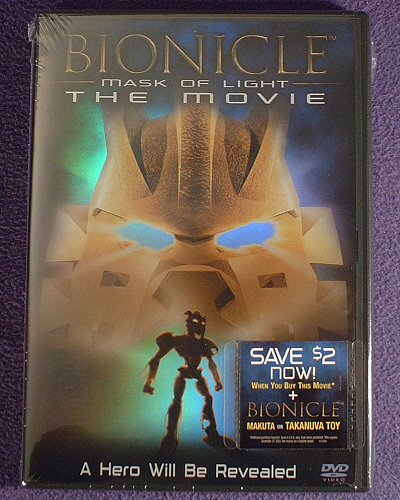
In this part, we’re covering the second screen of DVD bonus features.
CUTTING ROOM FLOOR:
At first I couldn’t understand the point of releasing a DTV movie that actually includes cut scenes as a bonus feature. It’s somewhat understandable for a theatrical release, where you might have had to trim the movie down for the benefit of people sitting in dark theatres drinking small buckets of caffienated pop, but if they’ve got a Pause button sitting next to them when they’re watching it, that’s not really an issue, so why not include them in the movie?
Then I watched them. The first clip was a one-liner that kinda spoils a plot point (if you can figure out where it came from). The second clip was a fairly slow bit of unnecessary exposition that would have seriously bogged down the early part of the movie, and it’s missing a few sound effects. The fourth one has one line from TAHU NUVA, half a word from VAKAMA (he gets cut off right at the end), and it’s very obvious that there’s some dialogue missing in between. The rest are absolutely silent. Fortunately, they include a Directors’ Commentary track that you can listen to, which both explains a lot of why they were cut, and helps to fill the empty silence of about half of the 2 minutes and 35 seconds of cut footage. The movie stands improved by the loss of some of these scenes, and they probably do still deserve a spot on the DVD, but some of the last bits are half-second scenic views that pop by so fast that the only way you can really take the time to appreciate the work that went into them is to hit the pause button.
STORYBOARD TO FILM COMPARISON:
This was a pretty cool feature, showing the first real fight sequence tucked into the lower left corner of the screen, and hand-drawn storyboard shots sequenced in time with the video clip in the rest of the screen. You can toggle the “camera angle” button to switch the storyboards out for a very simple untextured “greyscale” 3D animatics sequence. More than anything on the DVD, this feature will give you an idea of how much work went into the animation process, as you can see exactly how much detail was added to the final cut.
TRANSLATION CHART:
If you still don’t have a translation chart available through one of the dozen or so sources that have included it, now’s your chance to get one. It’s nothing particularly fancy, but it includes a full chart of all the letters. Unfortunately, instead of including the MATA NUI font versions of the numbers 0-9, they include glyphs for the numbers 1-9. They don’t include the number 0, two of them appear to be images of the original HAU, five others are the rest of the GREAT KANOHI, and the remaining two appear to be the stones representing MATA NUI and MAKUTA. I guess the nice thing about the inclusion of the letter chart is that there are a few instances in the movie where you can find stuff written out in the MATA NUI font.
MOVIE TRAILERS:
They included both the Teaser Trailer (it basically just shows the island, the MASK OF LIGHT, and the title image) and the Story Trailer (first revealed at the MASK OF LIGHT premiere party during Toy Fair 2003 in NYC and featuring actual footage from the movie).
REGISTER YOUR DVD:
When I first heard that there would be DVD-ROM content on this, I was expecting a link to a webpage, but this is all I could find. It includes a hyperlink that will register your DVD for you (those without a DVD-ROM can still do so by visiting the webpage listed in the hyperlink screen). Registration makes you eligible for the Disc Replacement Program (hey, you never know when a sperm whale and/or a sentient petunia might come crashing down on your copy of the DVD), DVD technical support (no details on this, so I’m not sure what it’s about), and notification of special offers and updates on other BVHE DVD titles. No mention of an exclusive webpage, though I suppose that might fall under the “special offers” clause.
If you want to see the whole movie, click right here .
0 Comments